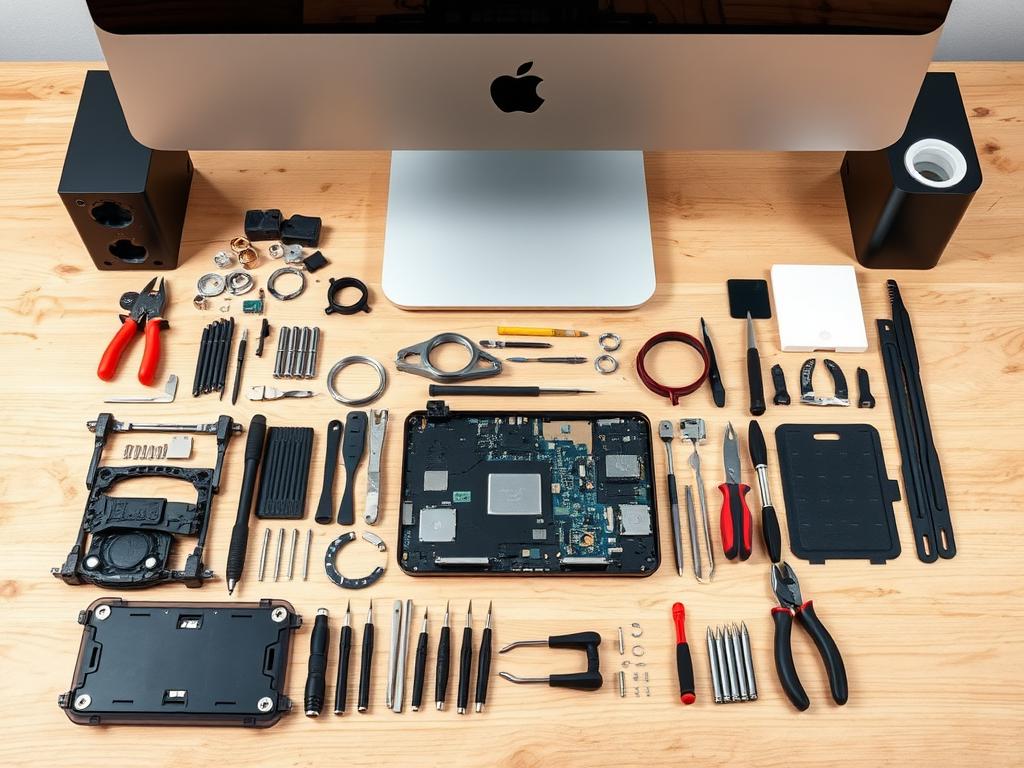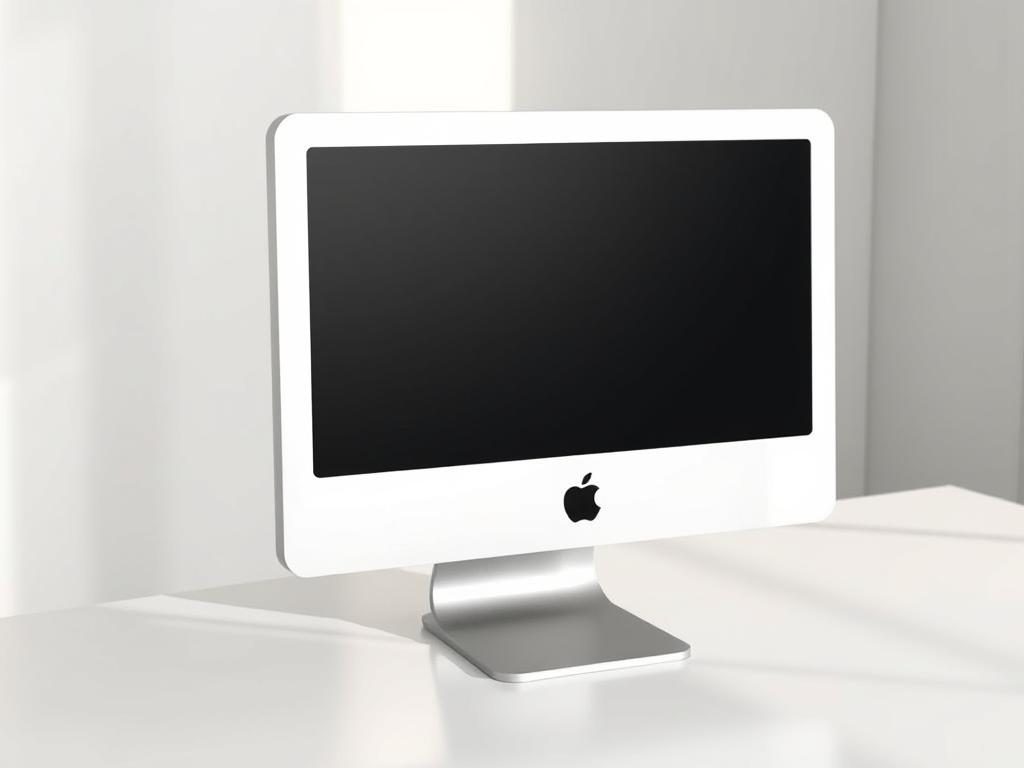How to Repair a 2008 iMac 20-Inch: Troubleshooting Guide
The 2008 iMac 20-inch marks a key point in Apple’s design journey. It’s a powerful computer with unique upkeep needs. Knowing how to fix your iMac can save money and make it last longer1.
Parts for this model cost between £0.80 and £1,600. The average price for a component is £481. Fixing a 2008 iMac requires a good grasp of its complex hardware.
Power supply issues are a common problem. They can stop the device from working entirely2. Expert iMac repair resources can help with tricky diagnostics.
This guide covers key 20-inch iMac upkeep methods. It addresses common hardware issues and offers practical fix-it tips. Knowing your device’s traits is vital for successful troubleshooting and part swaps1.
Our repair tips focus on cost-effective solutions. About 75% of replacement parts cost less than £401. This guide provides structured insights into effective repair methods.
Understanding Your 2008 iMac 20-Inch Specifications
The 2008 iMac 20-inch was a game-changer in Apple’s desktop computing line-up. It boasted powerful hardware and an innovative design. This guide delves into the iMac 20-inch specs, showcasing its impressive capabilities.
Processor and Memory Configuration
The 2008 iMac hardware packed a punch with its processor options. It featured 2.4 GHz or 2.66 GHz Intel Core 2 Duo processors. These had two cores and a 64-bit architecture3.
Users could customise their system’s memory. The standard RAM was 1 GB, with a maximum of 6 GB. However, Apple officially supported up to 4 GB.
The iMac had two RAM slots. These were 200-pin PC2-6400 DDR2 SO-DIMM slots.
Display and Graphics Capabilities
The iMac 20-inch sported an impressive glossy widescreen TFT LCD. It had a native resolution of 1680×1050 pixels4. The graphics performance was top-notch for its time.
Graphics options included the ATI Radeon HD 2400 XT with 128 MB. There was also the ATI Radeon HD 2600 PRO with 256 MB. External displays were supported up to 1920×1200 pixels.
Connectivity and Ports
The iMac offered a wide range of connection options4. It had three USB 2.0 ports and two FireWire ports. One was FireWire 400, the other FireWire 800.
For networking, it featured Ethernet 10/100/1000BASE-T. Wireless connectivity included built-in AirPort Extreme and Bluetooth 2.1 + EDR.
Essential Tools and Materials for iMac Repair
Preparing for an iMac repair requires a carefully chosen set of tools and maintenance equipment. A comprehensive iMac DIY kit is crucial for successful device restoration5. The right tools can make or break a repair job.

- Precision screwdriver set with multiple bit types
- Anti-static wrist strap
- Suction cups for screen removal
- Thermal material remover
- Compressed air for cleaning
When building your iMac maintenance equipment, consider the cost of parts. Prices typically range from £9.99 to £139.995. Quality tools are essential for safely handling delicate components like RAM and graphics cards6.
Precision and careful preparation are key to successful iMac repairs.
Safety is paramount when repairing iMacs. Use an anti-static wrist strap to protect sensitive electronics. Keep track of screws during disassembly to avoid mishaps7.
With the right tools and approach, even complex repairs become manageable. Dedicated technicians can tackle most iMac issues confidently.
How to Repair iMac 20 in 2008: Step-by-Step Process
Repairing a 2008 iMac 20-inch demands careful preparation and precise skills. This guide focuses on a systematic approach to professional component replacement. Understanding the iMac’s design is crucial for successful disassembly and restoration.
Safety Precautions Before Starting
Safety measures are vital before starting any iMac repair. Power down the device and unplug all electrical connections8. Wait 15 seconds after disconnecting before proceeding8.
Use an electrostatic discharge wristband to protect sensitive internal components. This step is crucial to prevent potential damage during the repair process.
Accessing Internal Components
The 2008 iMac 20-inch has fourteen magnets securing the glass panel9. Remove these magnets carefully using specialised tools. The front bezel is held by 12 Torx screws9.
Eight of these screws are 13 mm, while four are 25 mm T8 Torx screws9. Proper tools and a clean workspace are essential for this step.
- Gather necessary repair tools
- Use appropriate screwdriver sets
- Work in a clean, well-lit environment
Common Repair Procedures
When replacing iMac components, focus on delicate procedures. For hard drive removal, disconnect the SATA data and power cables using a spudger9. Handle the hard drive thermal sensor with care to avoid damage9.
| Component | Repair Difficulty | Tools Required |
|---|---|---|
| Hard Drive | Moderate | Torx screwdriver, Spudger |
| Memory | Easy | Anti-static wristband |
| Display Panel | Advanced | Specialised display tools |
Apple Diagnostics tests can help pinpoint specific issues8. Approach iMac disassembly with patience and precision. This careful approach ensures the device’s integrity throughout the repair process.
Upgrading Hardware Components
Revitalising your 2008 iMac through hardware upgrades can breathe new life into this classic machine. The upgrade process offers chances to boost performance and extend usability10.
RAM upgrades are crucial for improving iMac performance. The 2008 model supports up to 4GB of RAM. Upgrading from 2GB to 4GB can significantly enhance system responsiveness10.
This simple change can dramatically boost multitasking capabilities and application performance. It’s a cost-effective way to improve your iMac’s overall speed.
- Upgrade RAM from 2GB to maximum 4GB
- Potential total hardware upgrade investment: £300-£400
- Compatible with Mac OS X 10.11.6 El Capitan
Storage improvements offer another path for enhancing iMac performance. Replacing the 250GB hard drive with a 2TB option provides more space11.
This upgrade can also lead to potential speed enhancements. It’s an excellent way to future-proof your iMac.
| Upgrade Component | Original Specification | Upgraded Specification |
|---|---|---|
| RAM | 2GB | 4GB |
| Storage | 250GB HDD | 2TB HDD/SSD |
The 2008 iMac has limits with modern multimedia needs. However, strategic upgrades can extend its lifespan for basic computing tasks11.
Thoughtful RAM and storage improvements can transform your vintage machine. These upgrades can turn your old iMac into a more capable workstation.
Screen and Display Troubleshooting
The 2008 iMac screen repair needs careful handling due to its unique display features. It boasts a 20-inch widescreen LCD with 1680-by-1050 pixel resolution. The 18-bit LCD can show 262,144 colours12.
Common iMac display issues include colour inconsistencies, dead pixels, and backlight failures. These problems can greatly affect visual performance. Technicians must first pinpoint the specific issue before starting repairs.
Graphics cards like Radeon HD 2400 XT support external displays up to 1920 x 1200 resolution12. Proper colour calibration is vital for maintaining top-notch display quality. This involves fine-tuning colour balance and brightness for accurate visuals.
Replacing the 2008 iMac screen requires great care and attention to detail. It’s wise to seek expert help for complex display problems. Diagnostic steps include checking for damage and testing colour and pixel performance.
After repairs, thorough testing ensures the display works correctly. This step is crucial to meet the original specs of this classic Apple device.
FAQ
What are the key specifications of the 2008 iMac 20-inch model?
The 2008 iMac 20-inch boasts Intel Core 2 Duo processors, ranging from 2.0 GHz to 2.66 GHz. It offers 1-2 GB of RAM, upgradeable to 4 GB, and a 250 or 320 GB hard drive.
The model features an ATI Radeon HD graphics processor. It supports a 1680×1050 resolution display, providing crisp visuals for various tasks.
What tools do I need to repair my 2008 iMac 20-inch?
Key tools include a precision screwdriver set, anti-static wrist strap, and suction cups for screen removal. You’ll also need plastic prying tools and a clean, well-lit workspace.
Specialised Apple repair kits are highly recommended. These ensure compatibility and help prevent accidental damage during repairs.
Can I upgrade the RAM in my 2008 iMac?
Yes, you can boost the RAM from 1-2 GB to a maximum of 4 GB. This upgrade can greatly improve system performance and multitasking abilities.
Make sure to use compatible DDR2 SO-DIMM memory modules. These should be specifically designed for this iMac model.
What are the most common display issues with this iMac model?
Frequent display problems include dead pixels, backlight failure, and colour inconsistencies. Screen brightness issues can also occur in this model.
You can diagnose these using built-in macOS display tests. Connecting an external monitor helps isolate hardware-specific problems.
Is it difficult to replace the hard drive in a 2008 iMac 20-inch?
Replacing the hard drive requires moderate technical skill. You’ll need to remove the glass panel and LCD screen carefully.
Disconnecting internal connections and properly installing the new drive is crucial. It’s a feasible DIY repair for those with some technical experience.
What connectivity options does this iMac model offer?
The 2008 iMac 20-inch includes FireWire 400 and 800 ports, plus multiple USB 2.0 ports. It also features Ethernet, an optical audio output, and a built-in iSight camera.
This model supports various peripherals and networking connections typical of its generation.
How can I improve the performance of my 2008 iMac?
Boost performance by upgrading RAM to 4 GB and replacing the hard drive with an SSD. Regular software updates and keeping the system dust-free also help.
Consider reinstalling macOS to refresh the system if you’re experiencing significant slowdowns. This can often resolve persistent performance issues.
What safety precautions should I take when repairing my iMac?
Always unplug the device and use an anti-static wrist strap before starting repairs. Work in a clean, well-lit area and handle components with care.
Avoid humid environments during repairs. Ground yourself before touching internal components to prevent electrostatic discharge damage.
Source Links
- Mac Repair Guides for Apple Macbook, iPad, Powerbook iPhone & iPod
- What to do when your iMac won’t turn on?
- iMac “Core 2 Duo” 2.4 20″ (Early 2008) Specs (Early 2008, MB323LL/A, iMac8,1, A1224, 2210): EveryMac.com
- Apple 20” iMac (Early 2008); iMac8,1 Installation Guides and Specifications
- iMac Intel 20″ A1224 Parts | iFixit
- iMac 20″ (Late 2008) Freezing Issues
- Replacing Nvidia 8800 GS on 2008 imac: Tips/Guide
- Mac Won’t Boot or Start? How to Fix Issues With a Mac Not Turning On
- iMac Intel 24″ EMC 2267 Hard Drive Replacement
- Update 2008 imac so it isn’t obsolete?
- 24″ Early 2008 iMac Upgrades
- 20″ iMac (Early 2008)


















